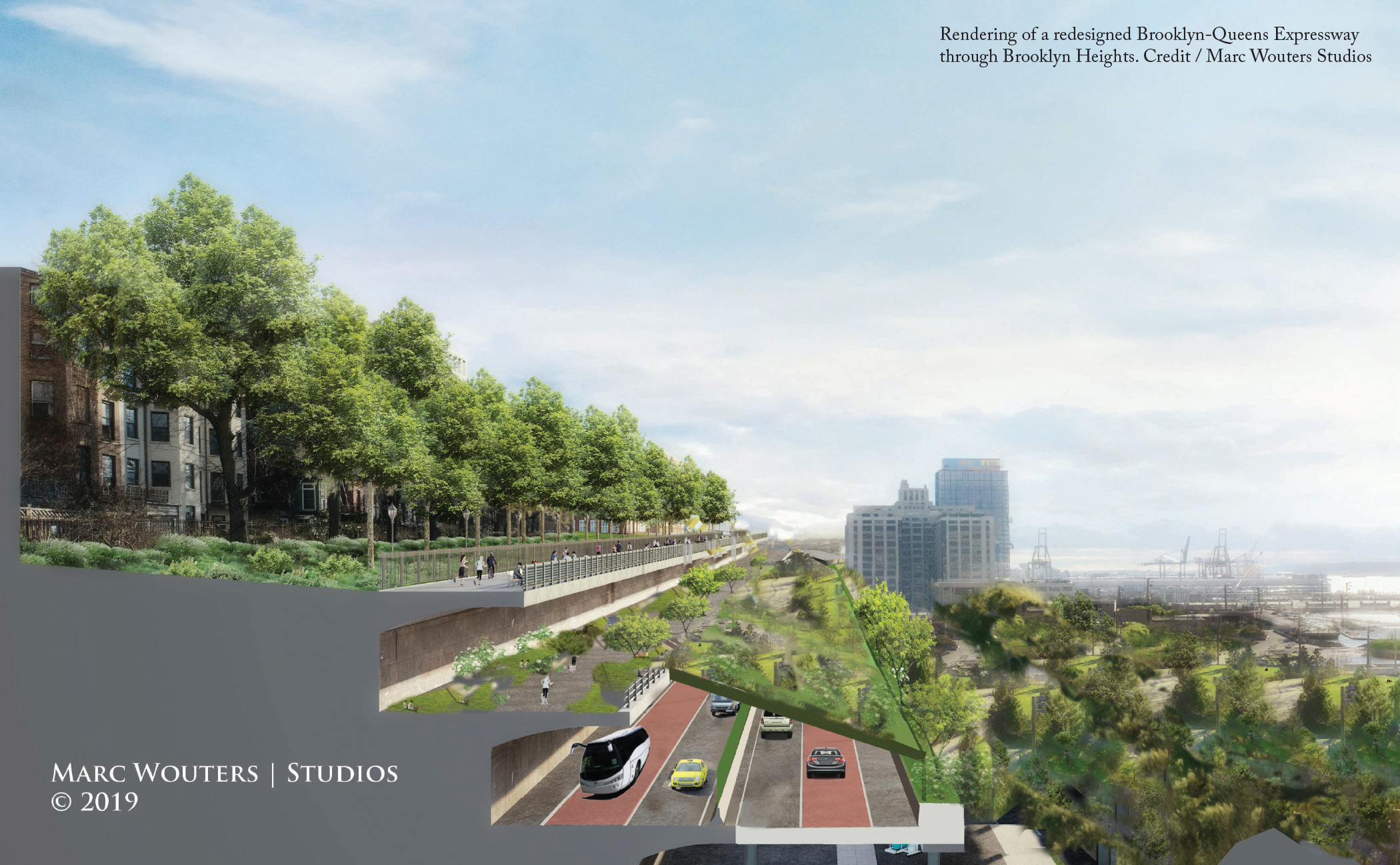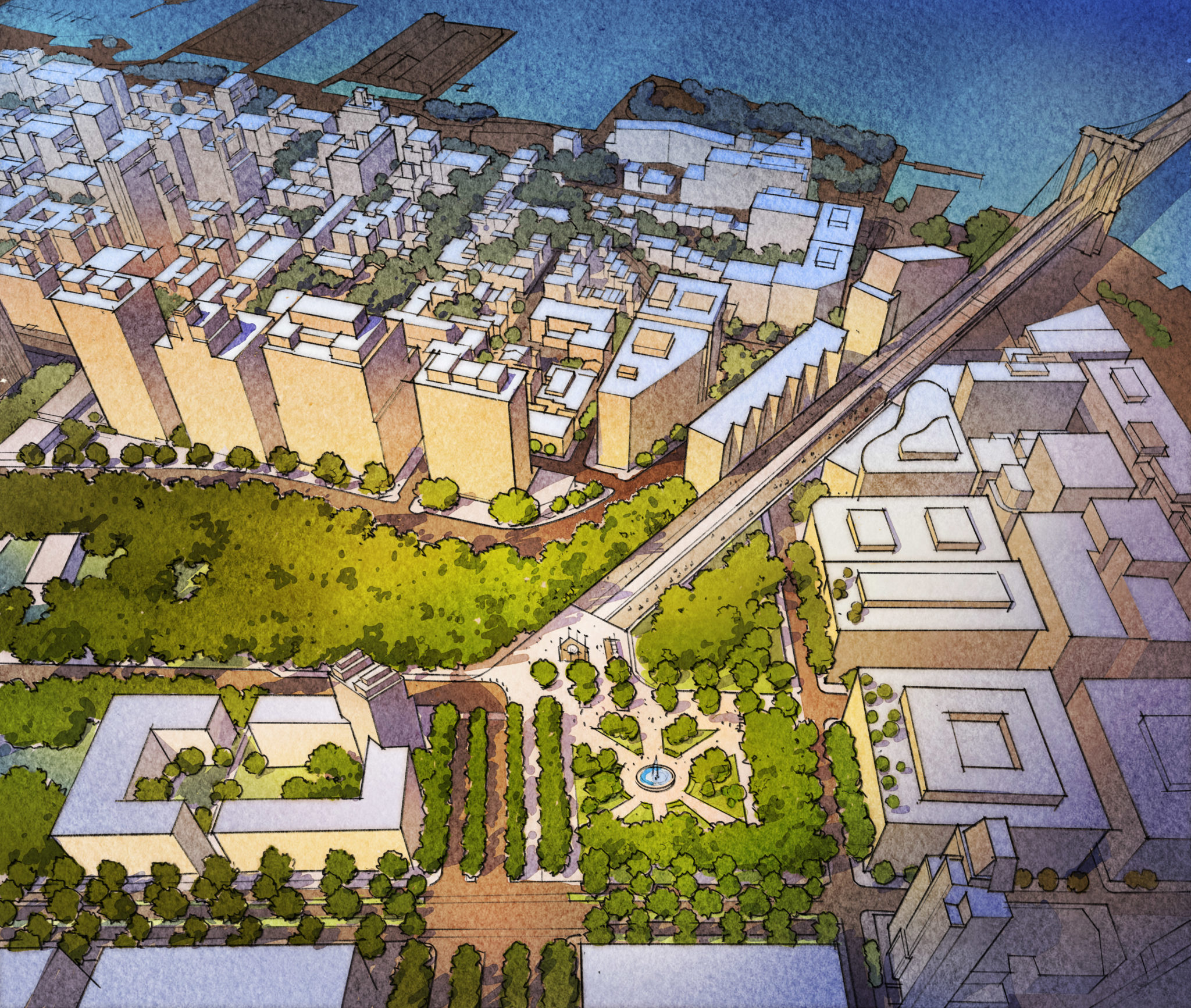History and Context
The Brooklyn-Queens Expressway (BQE) represents the paradox of famed highway builder Robert Moses’ legacy. The roads, parks, bridges, and housing he constructed that reshaped New York City and Long Island to serve the public resulted in the displacement of thousands of families, destruction of tight-knit neighborhoods, and overall were built at the expense of innumerable people and communities of color. The BQE is no exception. Today, as the aging highway crumbles, New York City needs to decide if there’s a better way forward.
The current path of the Brooklyn-Queens Expressway (BQE), at least the portion in Brooklyn Heights, was built out of compromise. To the south, Robert Moses built a tall elevated highway directly through the working-class Red Hook neighborhood, separating it from the rest of the borough. It then cuts a wide trench through Cobble Hill. Moses originally intended the highway to continue straight through Brooklyn Heights, but community protests against this plan prevailed. Instead, the BQE skirted the edge of Brooklyn Heights in its current form as a multi-level cantilevered roadway that forms an effective wall between Brooklyn and its waterfront. The popular Brooklyn Heights promenade was also built as part of this compromise.
Proposal
Because the Brooklyn Heights section is in dire need of repair and immediate action, planning for the future of this part of the road has received the majority of attention as of late. In particular, a plan to temporarily transform the Brooklyn Heights promenade into a highway while the BQE below it was repaired over several years drew a lot of ire and raised questions about how best to go about rebuilding the road. While that plan was halted through efforts by several area organizations, the developments also sparked conversations about what to do with the remaining ten miles of the BQE that run through some of the densest parts of Brooklyn and Queens.
It is clear that the highway has a detrimental effect on every neighborhood that it passes through, although some are more seriously affected than others. In particular, the wide footprint of the viaducts through the Navy Yard and Greenpoint neighborhoods have facilitated the design of auto-centric streets underneath them that are dangerous for pedestrians to cross. The trenched portion in Cobble Hill can only be crossed at a limited number of access points. And the entire highway subjects thousands of nearby residents to the concentrated exhaust of over 150,000 vehicles per day, many of which are funneled to the BQE to travel the toll-free Brooklyn and Manhattan Bridges.

To remedy these issues, a wide variety of organizations have put forward alternate visions for the future of the BQE, some of them limited to particular neighborhoods and others more wide-sweeping. The Cobble Hill Association has called for a cap over the trenched part of the highway in their neighborhood. Marc Wouters Studios’ has proposed a relatively low cost series of public terraces that would extend the promenade over a reduced-width highway. New York’s Institute for Public Architecture focused its Fall 2020 residency on what could be built in place of the BQE if the highway was removed altogether. These are just a handful of the ideas that grapple with the problematic BQE.
While these plans differ in scope and scale, they share a single principle: they all seek to repurpose the space the highway occupies in ways that improve the quality of life for residents along the corridor. As New York City and State consider what to do with the outdated expressway in Brooklyn Heights, they should follow this lead and make sure to prioritize all neighborhoods along the corridor before they develop future plans. The transformation of the BQE offers a once-in-a-generation opportunity to create a more livable Brooklyn and Queens and should be seriously considered.
Proposal 2
In a guest column for the New York Daily News, architect and urban designer John Massengale and ex-Milwaukee mayor and former leader of CNU John Norquist proposed removing the BQE (I-278) between the Battery Tunnel and the Kosciuszko Bridge. Check out an excerpt from their column:
Studies show that when city highways disappear, a lot of traffic disappears with them. Look at the traffic reduction on the cross-streets north and south of Manhattan’s new 14th St. busway. Opponents of the plan predicted the busway would cause a Carpocalypse. They were wrong.
In recent decades, cities all over the world removed expressways, and in every instance, traffic distribution improved. San Francisco, Portland, Oregon, Paris, Seoul, Chattanooga and Milwaukee took down highways, improving each city.
Removing the BQE between the Battery Tunnel and the Kosciuszko Bridge would save billions of dollars, reduce traffic going into Manhattan, and reduce traffic and pollution in Brooklyn. The worst air quality in the city is always found near major roads and highways.
But let’s be clear: This is about much more than reducing traffic, traffic deaths and pollution, as good as that all would be. When Robert Moses built the BQE, he demolished the buildings on the blocks around the Brooklyn and Manhattan bridges. That contributed to the decline of what is now called Dumbo.
Six decades later, the luxury housing there makes the land taken up by highway ramps and befouled by traffic valuable too.
If we removed the ramps and reduced the number of cars, New York City would own several new blocks of land for affordable housing in one of the highest-priced parts of Brooklyn.

On the Manhattan side of the Brooklyn Bridge, Chambers St. used to go through the Municipal Building to a dense urban neighborhood. Now the gateway to Manhattan is a 24-hour mass of irritated drivers honking at pedestrians trying to get from the subway to City Hall Park. There are enough existing ramps that all the cars could be redirected back towards Water St. and the FDR Drive. That would free up the no-man’s land between Park St. and Centre St. for a great new public space at the foot of the Brooklyn Bridge.
Why stop there, though? There are three ways for cars to cross the Hudson River into Manhattan. There are 16 car routes between Manhattan and the other boroughs. If we’re trying to reduce traffic — and we are — it’s crazy to have so many ways in.
Of all the bridges into Manhattan, the Brooklyn Bridge is the most popular for cyclists and pedestrians, and easily the most invigorating experience.
How great would it be to close it permanently to everyone but people on foot and on bikes? The nearby Battery Tunnel and Manhattan Bridge, combined with the other five bridges and tunnels just below 60th St., can still bring far more cars than we want in lower Manhattan.
If New York City is going to spend billions of dollars on infrastructure at this time in our history, it should not spend the money on cars. The pending collapse of the BQE is an opportunity to go in a better direction for all.


















